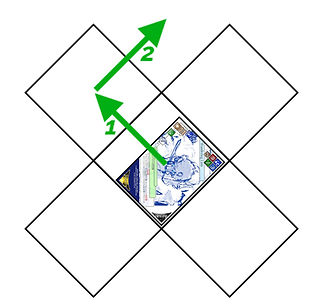How to Play Kyoukai
Introduction - Summary and Winning
Kyoukai's field is a 5 x 5 Diamond of zones, with cards played at a 45 degree angle.

Every card is a Gate that you open on the field.
Each deck has an Entrant Gate representing you, a Deck of 40 Gates, and a Spirit Deck.
Start the game by drawing a hand of 5 Gates from your Deck.
Draw 1 more as each turn starts, except this first one.
Your Entrant starts the game in the corner of the field closest to you, and your presence grows from there!
Manage your Units and Gates in hand to approach your Opponent's Entrant, and deal 20 to them to Win!
Although you can Open as many Gates as you want from your hand or Spirit Deck each turn, you can only Open them Rested, into zones bordering your Ready Gates already on the field - such as your Entrant.
In this board state, you can only open Gates in these blue zones.

Make sure any Gate you open from your hand is Rested like this (turned so that its Resting Arrow points towards you), showing that it can't take its Turn Action yet!
After you Open a Gate with Stats in its top corner like Wandering Lion or Childhood Guardian,
it stays in play.
It remains Rested until the start of the next turn, unless another effect Readies it.
Gates Open with their Open Effect - the text boxes on the top of a Gate, consisting of a Cost and Resolutiuon. Check out Read Gates for more on this!


After you open a Gate without Stats like Punch or Block, it's discarded after its Sequence resolves. Check out Read Gates for more info on Open Effects, and Sequences for more on Sequences!


Taking your Gates' Turn Action


During your turn, in addition to Opening Gates from your hand, you may also
Rest a Ready Gate to have it take a Turn Action.
That means Optionally Moving it, then
Attacking or using its Skill.
When you Move a Gate in this way, you can just
Rest it and move it to a Zone within its
Movement Range.
After that, or if you chose not to move, you can immediately
either Attack with that Gate or use its Skill. When you do this, your
Opponent can respond with Fast Skills and Fast Gates, to do things
like Dodge, Block, or even Counterattack!
An Attack is essentially an unwritten Skill, which essentially works like this:
Being able to Attack or use a Skill immediately after
movement is exclusive to Turn Actions! If a Gate moves because
of another Gate's Skill, it won't Attack or use its Skill after.
! - If you choose not to Attack or use a Skill after moving during a Turn Action,
you will not be able to use that Gate again later in the turn unless it becomes Ready again, or if its Skill specifically says you can.
! - Likewise, If you choose not to move a Gate before having it Attack or use its Skill, it will not be able to Move this way later in the turn unless it becomes Ready again.
Check out Gate Effects for more on this!

Kyoukai movement is very similar to the Strategy RPG's that inspired it!
Imagine choosing a Unit, Moving it within its Range, then choosing from its remaining menu options
("Attack" and "Skill").

These are the zones within the attack range of the Lion. It could also attack the green spaces by Attacking without Moving (but its Turn Action will end there.)
These are the zones within the Lion's movement range.
Calculating Damage
Any Gate with Stats, except your Entrant, will have 1 Life. Damage dealt to a gate is reduced by the Defense of the Gate in that zone. In other words, dealing 6 to a Gate with 6 defense will leave the damaged gate in play, but dealing 7 will Discard it.
Defense resets to full at the End of each Sequence, and so having multiple effects that deal damage on the same sequence can get over large defenses. See Sequences for more info!


Sequences
If you've played Yugioh, this is the Chain Link system.
If you've played Magic the Gathering, this is the Stack, but without interrupting - once any effect resolves, you can no longer add to the Sequence.


Punch, Wandering Lion, and Primal Instinct can only be used as Spell Speed 1, or at Sorcery Speed.
Hunting Eagle can only be opened as Spell Speed 1, or at Sorcery Speed, but its Skill, Rapid Instinct, can be used as either Spell Speed 1 or 2, or at Sorcery or Instant Speed.
Block can be opened at either Spell Speed 1 or 2, or at Sorcery or Instant speed.


The diagram below shows the flow of the Sequence System - each time you do any of the following, your Opponent can respond with their Fast Gate or Fast Skill, and if they don't, you can. Each Fast Gate or Skill also restarts this process, and it only ends when both players choose not to respond to a single effect.
At that time, all effects resolve backwards - first in, last out.

Field Setup
As the game progresses, you'll need space on the table for the following areas and piles:
-
Your Deck and Spirit Deck.
-
Your Discard and Shattered Piles (these start empty, until Gates are sent there).